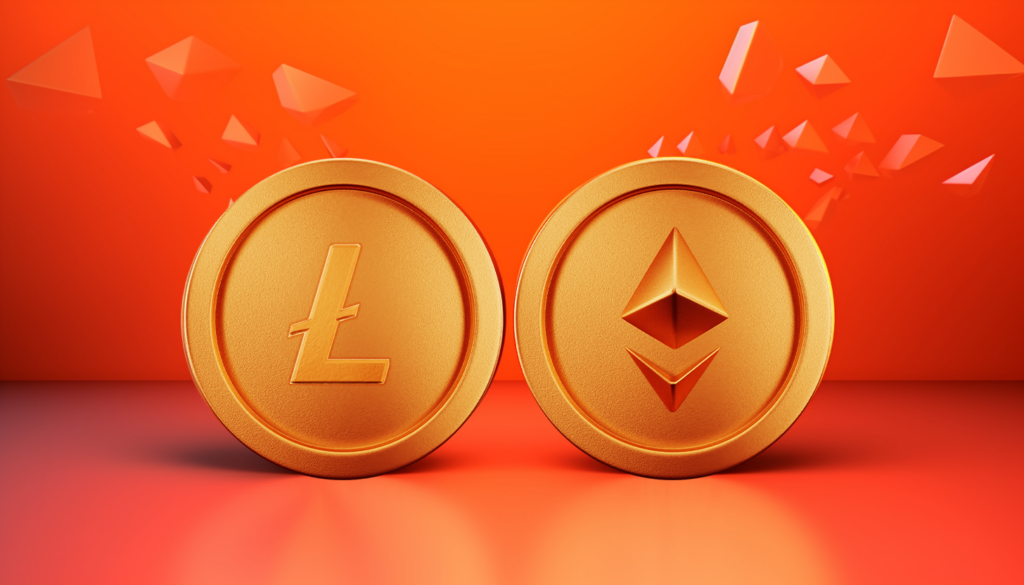
You’ve probably heard of Bitcoin – the big name in the cryptocurrency world. But today, we’re diving into two other digital coin superstars: Litecoin and Ethereum. It’s not just about picking team blue or team green. Each has its own unique features, strengths, and uses. Whether you’re curious about dabbling in digital coins or simply looking to learn more about these crypto giants, join us as we dive deep into the Litecoin vs. Ethereum.
Short summary
Litecoin and Ethereum are distinct cryptocurrencies with unique features; Litecoin focuses on fast and affordable transactions, while the Ethereum network emphasises smart contracts and a platform for decentralised applications.
Key differences lie in their consensus mechanisms, hashing algorithms, and network scalability, with Ethereum transitioning to a more energy-efficient proof-of-stake and Litecoin retaining its proof-of-work model.
Both offer robust security features and decentralisation, ensuring transparent, trustworthy transactions and operations across their networks.
Contents
- Understanding Litecoin and Ethereum
- Comparing key features
- Transaction speed and fees
- Security and decentralisation
- Summary
- Frequently asked questions
Understanding Litecoin and Ethereum

Think of Litecoin and Ethereum as two totally different apps on your phone. Litecoin, created by Charlie Lee in 2011, is like a speedy version of Bitcoin, aiming to process transactions quickly and efficiently—it’s like your go-to messaging app that sends texts in a flash! On the other hand, Ethereum, cooked up by Vitalik Buterin in 2015, isn’t just about sending and receiving coins. It introduces ‘smart contracts’—think of them as customisable mini-programs running on the blockchain. So, while both Litecoin and Ethereum are cryptocurrencies, they have different purposes and features. It’s a bit like comparing your favorite game app with a handy productivity tool—both super cool, but in different ways!
Litecoin’s purpose
Litecoin is like the slightly younger sibling to Bitcoin, named . It was created back in 2011 by a guy named Charlie Lee, with the idea of being the “silver” to Bitcoin’s “gold”. In simpler terms, if Bitcoin is like the big, fancy store downtown where everyone goes to buy expensive things, then Litecoin is like the local convenience store – faster, more accessible, but still pretty cool. It was designed to process transactions quicker than Bitcoin, making it a great choice for smaller purchases and everyday use. So, in a way, while Bitcoin is often seen as a store of value (like gold bars in a vault), Litecoin is more like the change in your pocket, always ready to be spent.
Ethereum’s vision
Think of the Ethereum network like a massive LEGO set, but for the digital world. Instead of just being another cryptocurrency like Bitcoin, Ethereum wanted to be a platform where people can build anything they dream up, using special pieces called “smart contracts.” Imagine building a LEGO castle that can move its drawbridge all by itself whenever someone approaches. In the digital space, these smart contracts are like self-operating programs that follow specific rules. So, Ethereum’s big vision is to create a world where anyone can design their own projects, games, or even digital businesses, all without needing a middleman like a bank or a company. It’s like giving everyone the tools to be their own inventor, but in the online universe!
Comparing key features

Alright, so imagine Ethereum and Litecoin are like two different types of cars. Both can get you from point A to B, but they have different features under the hood. Let’s dive into how they’re built and how they operate, so we can get a better sense of what makes each one unique.
Consensus mechanisms
When it comes to cars, we have traffic rules to keep things in order, right? Similarly, in the cryptocurrency world, we have something called a “consensus mechanism” to make sure everyone plays fair and agrees on the same version of events. Ethereum originally used something called “Proof of Work” (like Bitcoin) where computers compete to solve complex math problems. After transitioning to proof-of-stake, Ethereum now consumes roughly 99% less energy than before and is far more cost effective, efficient and ecologically friendly as well. On the other hand, Litecoin continues to run its platform with an unchanged proof-of-work model.
Hashing algorithms
Now, onto the engines! If our cryptos are cars, then hashing algorithms are like their engines. They take in data, churn it up, and output a fixed code, ensuring everything’s secure. Ethereum uses something called “Ethash” for its engine, which is tailor-made for Ethereum’s needs. Litecoin, however, runs on “Scrypt”. It’s like choosing between a diesel and petrol engine; both do the job but have their own strengths and quirks.
Network scalability
Lastly, let’s talk about how many passengers these cars can carry, or in crypto terms, “network scalability”. If too many people try to use a cryptocurrency at once, it can get congested, like a traffic jam. Ethereum has faced some scalability issues in the past, but they’re working on solutions, like Ethereum 2.0, to handle more transactions. Litecoin, being a bit lighter and designed for faster transactions, can handle its traffic pretty smoothly, but it’s still smaller in scale compared to the big highways Ethereum aims to build.
Transaction speed and fees

Okay, let’s think of cryptocurrencies like online shopping. You’ve put something in your cart, and now you’re deciding between standard shipping (takes a bit longer, might be cheaper) and express shipping (super quick, but maybe pricier). In the crypto world, the “shipping” is how fast your transaction gets processed and how much it costs. So, let’s break down these “shipping” options for our digital money.
Transaction speed
Imagine you’re sending a digital coin to your friend. How fast that coin gets to them is the transaction speed. Some coins are like lightning – zap, and they’re there! Others might take a bit longer, like waiting for that slow pizza delivery. Ethereum, for example, can be pretty quick, but if their network is super busy, it might slow down. Litecoin, on the other hand, is designed to be speedy Gonzales, with a goal of processing transactions in just 2.5 minutes. So, it’s kinda like choosing between express and standard delivery, each coin has its own pace.
Transaction fees
When it comes to transaction fees, Litecoin is the clear winner in terms of affordability and practicality for everyday use. Usually transactions with Litecoins cost around $0.0070 which makes them suitable for even smaller transactions compared to Ethereum whose gas-based system can result in higher costs depending on complexity and network demand during peak times.
Security and decentralisation

Imagine you’ve got this super secret diary where you write down all your thoughts. Now, instead of keeping it under your pillow (because let’s be honest, everyone checks there), you’ve made copies and given them to a bunch of trusted friends. This way, even if one friend loses their copy or someone tries to change what you wrote, the others can vouch for the original content. This idea of spreading things out for safety is at the heart of ‘security’ and ‘decentralisation’ in the world of cryptocurrencies. Let’s dive deeper.
Security features
The first thing to know about crypto is that it’s super focused on keeping things secure. It’s like having a diary with a hi-tech lock and an alarm system. Cryptocurrencies use complex math (called cryptography) to make sure your coins are safe and transactions are legit. Both Ethereum and Litecoin have their own “security guards”. Ethereum uses its unique ‘Ethash’ (remember, like its engine?), while Litecoin employs ‘Scrypt’ to keep things tight. These are like special codes that ensure no sneaky folks can tamper with your digital money or fake transactions.
Decentralisation Levels
Back to the diary example! Instead of one person or company being in charge (like a bank), cryptocurrencies spread their data across many computers worldwide. This is called ‘decentralisation’. It’s like if every time you wrote in your diary, all your friends with copies updated theirs too. So, if someone tried to sneak in and change an entry, the others would be like, “Hey, that’s not what the original said!” Ethereum and Litecoin both use this principle. By being decentralised, they make sure that no single group can control or mess with the system, making everything more transparent and trustworthy.
Summary
Litecoin and Ethereum are distinct pillars in the cryptocurrency landscape. Litecoin is tailored for quick and efficient transactions, while Ethereum offers versatility with its smart contracts. They differ in aspects like transaction speeds, fees, and core designs. By understanding these differences, users can navigate the crypto world more effectively. Both have their strengths, making them indispensable in the realm of digital currencies.
Frequently asked questions
What’s the main difference between Litecoin and Ethereum?
The primary difference is their purpose. Litecoin is designed primarily as a currency for fast and affordable transactions. Ethereum, on the other hand, is not just a cryptocurrency but also a platform for decentralised applications and smart contracts.
How do Litecoin and Ethereum differ in terms of transaction speed and fees?
Litecoin is optimised for speed, aiming to process transactions in about 2.5 minutes, making it faster than Ethereum. In terms of fees, Litecoin transactions are generally cheaper, especially for everyday use, while Ethereum’s gas-based fee structure can vary depending on network congestion and transaction complexity.
What is Ethereum’s vision with smart contracts?
The Ethereum blockchain aims to revolutionise the digital space by enabling users to create “smart contracts”, which are self-executing contracts with the terms directly written into code. These allow for customisable, decentralised applications to be built on the Ethereum platform without intermediaries.
Which consensus mechanism do Litecoin and Ethereum use?
As of 2023, Ethereum has transitioned from a proof-of-work (PoW) to a proof-of-stake (PoS) consensus mechanism, making it more energy-efficient. Litecoin, meanwhile, continues to use the proof-of-work model.
Are Litecoin and Ethereum secure?
Yes, both Litecoin and Ethereum employ strong cryptographic techniques to ensure transaction security. Ethereum uses its unique ‘Ethash’ hashing algorithm, while Litecoin utilises ‘Scrypt’. The decentralised nature of both cryptocurrencies further enhances their security against potential attacks.



